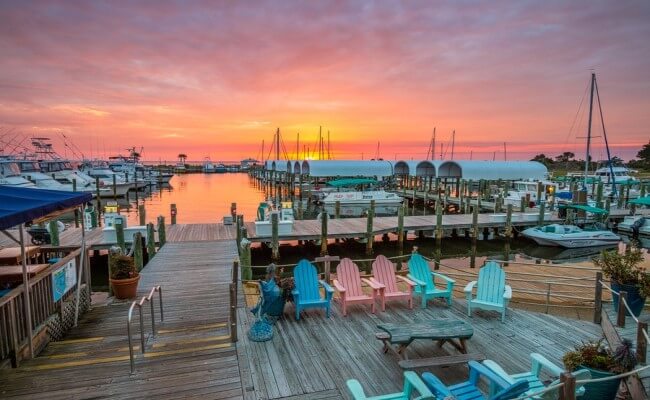5 Best Beaches in Florida for $6
Best beaches in Florida can be found on the extensive coastline where there are abundance of beaches. While it is difficult to provide an exact number, it is estimated that Florida has over 1,300 miles (2,092 kilometers) of coastline, which translates to a significant number of beaches. These beaches vary in size, features, and popularity.
Florida’s coastline includes a mix of renowned beaches like South Beach in Miami, Clearwater Beach, and Daytona Beach, as well as numerous lesser-known and secluded beaches. The state is home to famous beach destinations such as Destin, Fort Lauderdale, Naples, and Key West, each offering its own unique coastal experience.
In addition to the mainland beaches, Florida is surrounded by water on three sides, with the Atlantic Ocean to the east, the Gulf of Mexico to the west, and the Straits of Florida to the south. This geographical positioning provides ample opportunities for beach exploration and enjoyment throughout the state.
With such a vast coastline, Florida offers a wide range of beach experiences, from lively and bustling beaches in major cities to tranquil and secluded stretches of sand in more remote areas. Visitors and residents alike have a plethora of options to choose from when it comes to enjoying the sun, sand, and surf in the Sunshine State.
Best Beaches in Florida
Do you know for just a little more than the cost of a theme-park ice pop, you can spend some quality time on sandy beaches and natural springs or in the wildlife refuges of Florida. Isn’t it amazing and entertaining? Most parks charge $6 to $8 for entry, but all are worth visiting and you get a great opportunity to relax and enjoy nature.
1. Myakka State Park, Sarasota
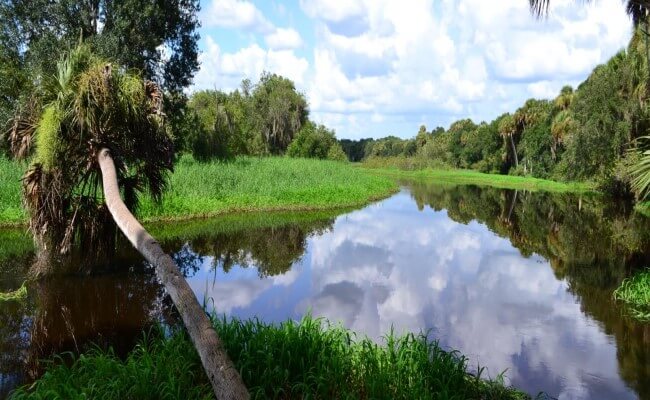
Myakka River State Park is a popular best beaches in Florida and expansive state park located in Sarasota, Florida. It is one of the oldest and largest state parks in Florida, covering an area of over 58 square miles (150 square kilometers).
The park and the best beaches in Florida is known for its diverse ecosystems, including wetlands, prairies, hammocks, and pinelands. It is centered around the scenic Myakka River, which flows through the park, providing opportunities for boating, canoeing, and kayaking. Visitors can rent boats, canoes, and kayaks, or take guided boat tours to explore the river and its surrounding habitats.
One of the park’s main attractions is the Myakka River’s Upper and Lower Lakes. These lakes offer beautiful scenery and are excellent for fishing, wildlife observation, and boating.
Myakka River State Park is also home to abundant wildlife. Visitors can spot alligators, deer, wild turkeys, sandhill cranes, and a variety of bird species. The park has several nature trails and boardwalks that allow visitors to explore the diverse flora and fauna up close.
For those interested in camping, the park offers both primitive and modern campsites, as well as cabins for rent. The park has picnic areas, a playground, and a visitor center with exhibits and information about the park’s natural and cultural history.
In addition to outdoor activities, the park hosts various events and programs throughout the year, including guided nature walks, tram tours, and educational presentations.
The entry fee is:
$6 per vehicle (up to 8 people) for a single day visit.
$4 per vehicle (up to 8 people) for a single occupant vehicle.
Pedestrians, cyclists, and motorcyclists are charged $2 per person.
Note that these fees are subject to change, and it’s always a good idea to check with the official website or contact the park directly to confirm the current entry fees and any other relevant information before your visit.
Myakka River State Park best beaches in Florida offers a wonderful opportunity to experience Florida’s natural beauty, enjoy outdoor activities, and immerse oneself in the state’s diverse ecosystems.
2. Blue Spring State Park, Orange City
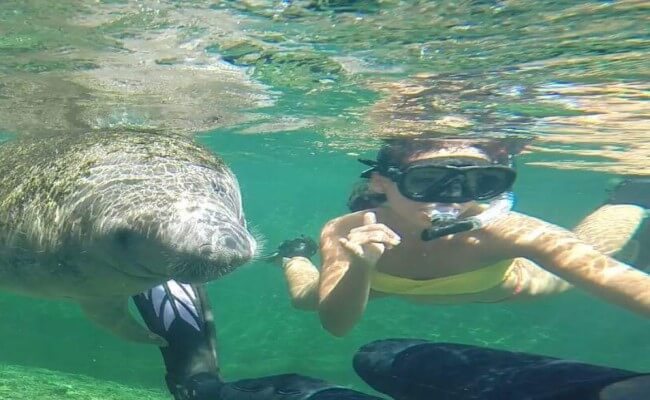
Blue Spring State Park is a popular state park and best beaches in Florida located in Orange City, Florida. It is renowned for its crystal-clear freshwater spring and the opportunity to observe manatees in their natural habitat during the winter months.
Blue Spring State Park offers a variety of activities and amenities for visitors to enjoy. Some of the key features and activities include:
- Blue Spring: The park’s main attraction is the Blue Spring, which is one of Florida’s largest springs. The spring flows into the St. Johns River and maintains a constant temperature of 72 degrees Fahrenheit (22 degrees Celsius). Swimming and snorkeling are allowed in the designated swimming area when manatees are not present.
- Manatee Viewing: During the winter months, typically from mid-November to late March, Blue Spring State Park becomes a vital winter refuge for manatees seeking warmer waters. Visitors have the opportunity to observe these gentle creatures from designated viewing areas. It is important to respect their space and follow park regulations to ensure their safety and well-being.
- Wildlife and Nature Trails: The park offers several scenic trails that wind through various habitats, including hardwood hammocks and pine flatwoods. These trails provide opportunities for hiking, wildlife viewing, and birdwatching. It is not uncommon to spot various bird species, turtles, alligators, and other wildlife within the park.
- Picnicking and Camping: Blue Spring State Park best beaches in Florida has picnic areas equipped with tables and grills where visitors can enjoy a meal surrounded by nature. The park also provides camping facilities, including tent and RV camping, with amenities such as restrooms, showers, and a dump station.
- Kayaking and Canoeing: Visitors can bring their own kayaks or canoes or rent them from the park’s concessionaire to explore the St. Johns River. Paddling along the river provides opportunities to view wildlife, enjoy the scenic landscape, and experience the park from a different perspective.
The entry fee is as follows:
- $6 per vehicle (2-8 people) for single-occupancy vehicles or vehicles with a capacity of up to 8 people.
- $4 per single-occupant vehicle.
- $2 per pedestrian or cyclist.
It’s important to note that park admission fees apply, and the fee structure can vary depending on the number of occupants per vehicle and whether the visit is during the peak manatee season. It’s recommended to check the official Blue Spring State Park website or contact the park directly for the most up-to-date information on entry fees, operating hours, and any additional regulations or guidelines.
3. Anastasia State Park, St. Augustine
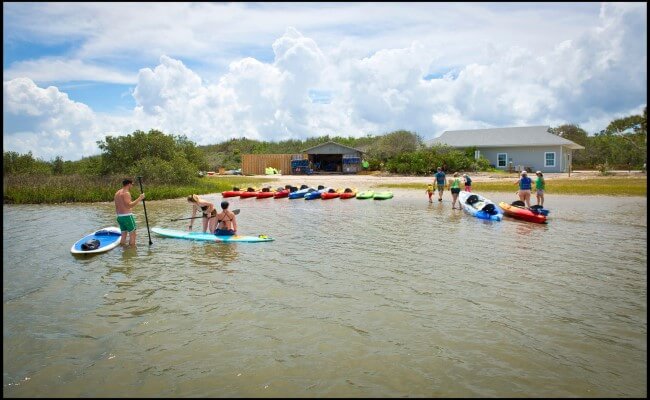
Anastasia State Park is a beautiful state park and one of the best beaches in Florida located in St. Augustine, Florida. It is situated on Anastasia Island, just across the Matanzas Bay from downtown St. Augustine. The park encompasses a diverse range of natural habitats, including pristine beaches, tidal marshes, maritime hammocks, and ancient sand dunes.
Here are some of the highlights and activities you can enjoy at Anastasia State Park:
- Beaches: Anastasia State Park is known for its stunning beaches. The park offers 4 miles (6.4 kilometers) of pristine, white sandy beachfront along the Atlantic Ocean. Visitors can swim, sunbathe, picnic, or take leisurely walks along the shore.
- Nature Trails: The park features several nature trails that wind through the coastal maritime hammocks and sand dunes. These trails provide opportunities for hiking, birdwatching, and wildlife observation. The Ancient Dunes Nature Trail is particularly popular, offering a glimpse into the unique ecosystem of the park.
- Water Activities: Anastasia State Park is an excellent destination for water activities. Visitors can enjoy swimming, surfing, paddleboarding, and kayaking in the ocean waters. There is also a tidal saltwater lagoon within the park, known as Salt Run, where you can go fishing, boating, or kayaking.
- Camping: The park offers a campground with over 130 campsites for tents or RVs. The campsites are equipped with picnic tables, grills, and access to restroom and shower facilities. Camping at Anastasia State Park provides an opportunity to immerse yourself in the park’s natural beauty and enjoy the serenity of the coastal environment.
- Wildlife Viewing: Anastasia State Park is home to a variety of wildlife species. Visitors may spot gopher tortoises, shorebirds, dolphins, and other marine life during their visit. The park is also a critical nesting site for endangered sea turtles, and guided turtle walks are organized during the nesting season.
To enter Anastasia State Park best beaches in Florida, there is an admission fee. The fee is $8 per vehicle (up to 8 people) for single-occupancy vehicles, or $4 per single-occupant vehicle. Pedestrians or cyclists are charged $2 per person.
It’s always recommended to check the official Anastasia State Park website or contact the park directly for the most up-to-date information on entry fees, operating hours, and any additional guidelines or regulations.
4. St. Marks National Wildlife Refuge, St. Marks
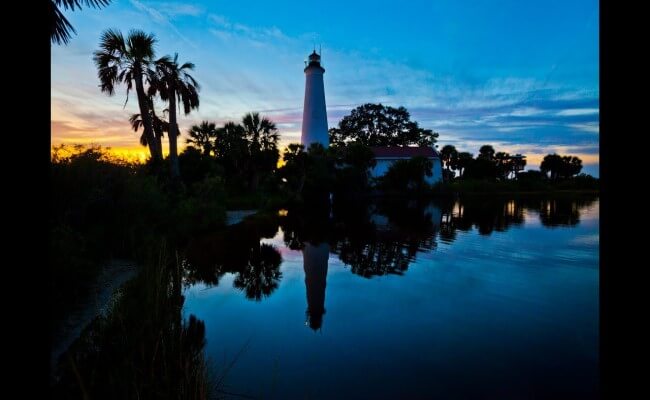
St. Marks National Wildlife Refuge is a scenic wildlife refuge and best beaches in Florida located in St. Marks, Florida. Situated along the Gulf of Mexico, the refuge encompasses a vast area of over 70,000 acres (28,300 hectares) and is known for its diverse ecosystems and abundant wildlife.
Here are some key features and activities you can experience at St. Marks National Wildlife Refuge:
- Wildlife Viewing: The refuge is home to a wide variety of wildlife, including migratory birds, alligators, deer, river otters, and more. The refuge is renowned as a major stopover point for migratory birds during their journeys, making it a prime location for birdwatching. Visitors can observe and photograph the diverse bird species from several observation points and trails throughout the refuge.
- Nature Trails: St. Marks National Wildlife Refuge offers a network of trails that wind through its diverse habitats, including marshes, forests, and coastal areas. The trails provide opportunities for hiking, wildlife observation, and exploring the natural beauty of the refuge. The Lighthouse Road Trail and the Florida Trail are popular options for visitors.
- Scenic Drives: The refuge features several scenic drives that allow visitors to explore the area by car. The Lighthouse Road, which leads to the historic St. Marks Lighthouse, offers picturesque views of the coastline and marshes. Another scenic drive is the Panacea Unit, which provides access to the refuge’s saltwater marshes and tidal flats.
- Fishing and Boating: St. Marks National Wildlife Refuge offers opportunities for fishing in designated areas. Anglers can target species such as redfish, trout, and flounder. Additionally, boating is permitted in certain areas, allowing visitors to explore the refuge’s waterways and coastal areas.
- Visitor Center and Educational Programs: The refuge has a visitor center that provides information about the wildlife, habitats, and conservation efforts within the refuge. The center offers exhibits, displays, and educational materials for visitors. Throughout the year, the refuge also hosts various educational programs, guided walks, and special events.
There may be an entrance fee to access certain areas of St. Marks National Wildlife Refuge best beaches in Florida, which supports conservation and maintenance efforts. The fee is $5 per vehicle for a seven-day pass. However, it’s always recommended to check the official St. Marks National Wildlife Refuge website or contact the refuge directly for the most up-to-date information on entry fees, operating hours, and any additional regulations or guidelines.
5. Highlands Hammock State Park, Sebring
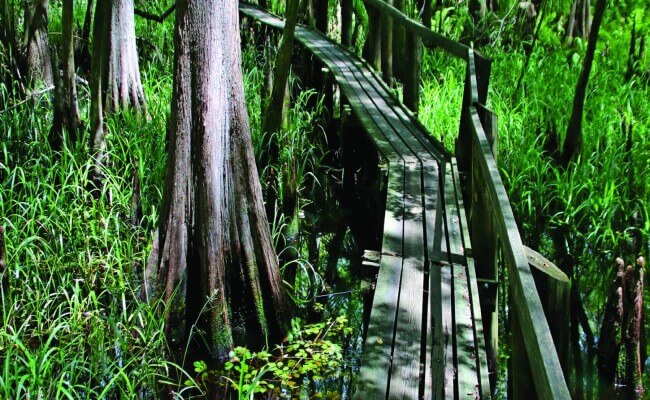
Highlands Hammock State Park is a picturesque state park and best beaches in Florida located in Sebring, Florida. It is one of Florida’s oldest state parks and is known for its pristine natural beauty, ancient hammocks, and diverse wildlife. The park spans over 9,000 acres (3,642 hectares) and offers a range of activities for visitors to enjoy.
Here are some of the highlights and activities you can experience at Highlands Hammock State Park:
- Nature Trails: The park features several nature trails that meander through ancient hammocks, cypress swamps, and pine flatwoods. The trails vary in length and difficulty, catering to different hiking preferences. The Ancient Hammock Trail, Cypress Swamp Trail, and Fern Garden Trail are popular choices for visitors. These trails provide opportunities to observe wildlife, admire towering trees, and immerse yourself in the park’s natural surroundings.
- Canopy Walkway: One of the unique features of Highlands Hammock State Park is the Canopy Walkway. This elevated boardwalk takes you through the treetops of the ancient hammock, allowing you to experience the park from a different perspective. The Canopy Walkway offers panoramic views of the surrounding forest and is a great spot for birdwatching.
- Camping: The park offers a campground with various camping options. There are over 130 campsites equipped with picnic tables, grills, and access to restrooms and showers. The campground provides a serene and peaceful environment for camping, surrounded by nature.
- Wildlife Viewing: Highlands Hammock State Park is home to a wide array of wildlife. Visitors may spot white-tailed deer, alligators, various bird species, butterflies, and other animals during their visit. The park’s diverse ecosystems make it a haven for nature enthusiasts and wildlife photographers.
- Tram Tours and Interpretive Programs: The park offers guided tram tours that provide an informative and scenic overview of the park. These tours are led by knowledgeable guides who share insights into the park’s history, flora, and fauna. Additionally, the park hosts interpretive programs, including ranger-led walks and talks, which offer educational experiences for visitors.
To enter Highlands Hammock State Park, there is an admission fee and the fee was $6 per vehicle (up to 8 people) for a single day visit. Pedestrians and cyclists were charged $4 per person. It’s always recommended to check the official Highlands Hammock State Park website or contact the park directly for the most up-to-date information on entry fees, operating hours, and any additional regulations or guidelines.
6. Bahia Honda State Park, Big Pine Key
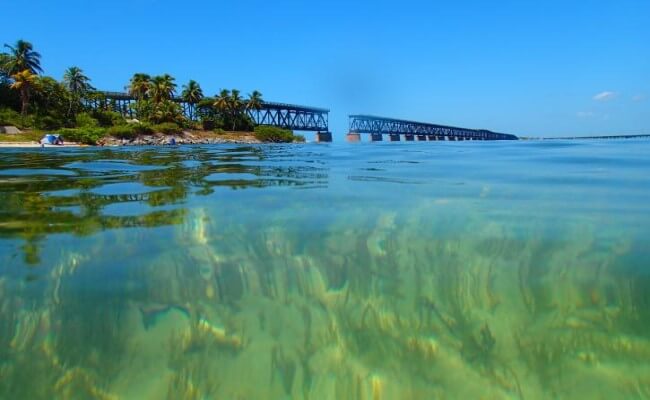
Bahia Honda State Park is another best beaches in Florida. This stunning state park is located on Big Pine Key in the Florida Keys. It is known for its pristine beaches, crystal-clear waters, and diverse marine life. The park covers an area of about 524 acres (212 hectares) and offers a range of recreational activities for visitors.
Here are some of the highlights and activities you can enjoy at Bahia Honda State Park:
- Beaches: Bahia Honda State Park best beaches in Florida is renowned for its beautiful sandy beaches. The park offers two main beach areas: Sandspur Beach on the Atlantic Ocean side and Calusa Beach on the Florida Bay side. Visitors can swim, sunbathe, snorkel, or simply relax and enjoy the coastal scenery.
- Snorkeling and Diving: The park is home to a thriving coral reef ecosystem, making it an excellent destination for snorkeling and diving. You can explore the vibrant underwater world teeming with colorful fish, corals, and other marine life. Snorkeling gear is available for rent at the park, and guided snorkeling tours are also offered.
- Kayaking and Paddleboarding: Bahia Honda State Park provides opportunities for kayaking and paddleboarding in the calm waters of the Florida Bay. You can rent kayaks or paddleboards from the park or bring your own to explore the mangrove-lined shorelines and observe marine life.
- Nature Trails: The park has several nature trails that offer opportunities for hiking and wildlife viewing. The Silver Palm Trail and Loggerhead Trail are popular choices, providing glimpses of the park’s unique ecosystems and wildlife, including migratory birds and various plant species.
- Camping: Bahia Honda State Park offers campsites for tent and RV camping. The campground provides amenities such as restrooms, showers, and picnic tables. Waking up to the sound of the waves and being surrounded by nature is a wonderful experience at Bahia Honda State Park.
To enter Bahia Honda State Park, there is an admission fee and the fee is $8 per vehicle (2-8 people) for single-occupancy vehicles, or $4 per single-occupant vehicle. Pedestrians or cyclists were charged $2 per person. It’s advisable to check the official Bahia Honda State Park website or contact the park directly for the most up-to-date information on entry fees, operating hours, and any additional regulations or guidelines.
Synopsis
If you ever plan to visit Florida, do not miss to check out these parks and beaches which are extremely cheap to visit and packed with loads of fun, entertainment, and specialties.
